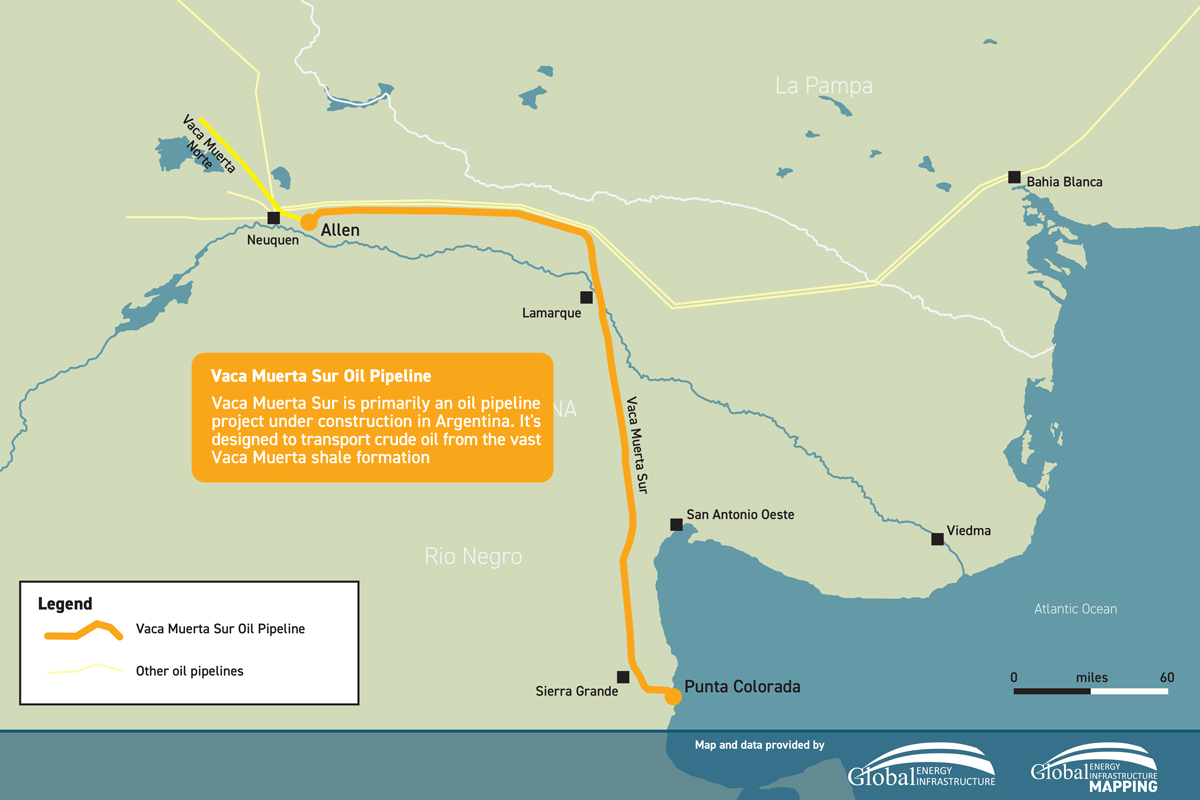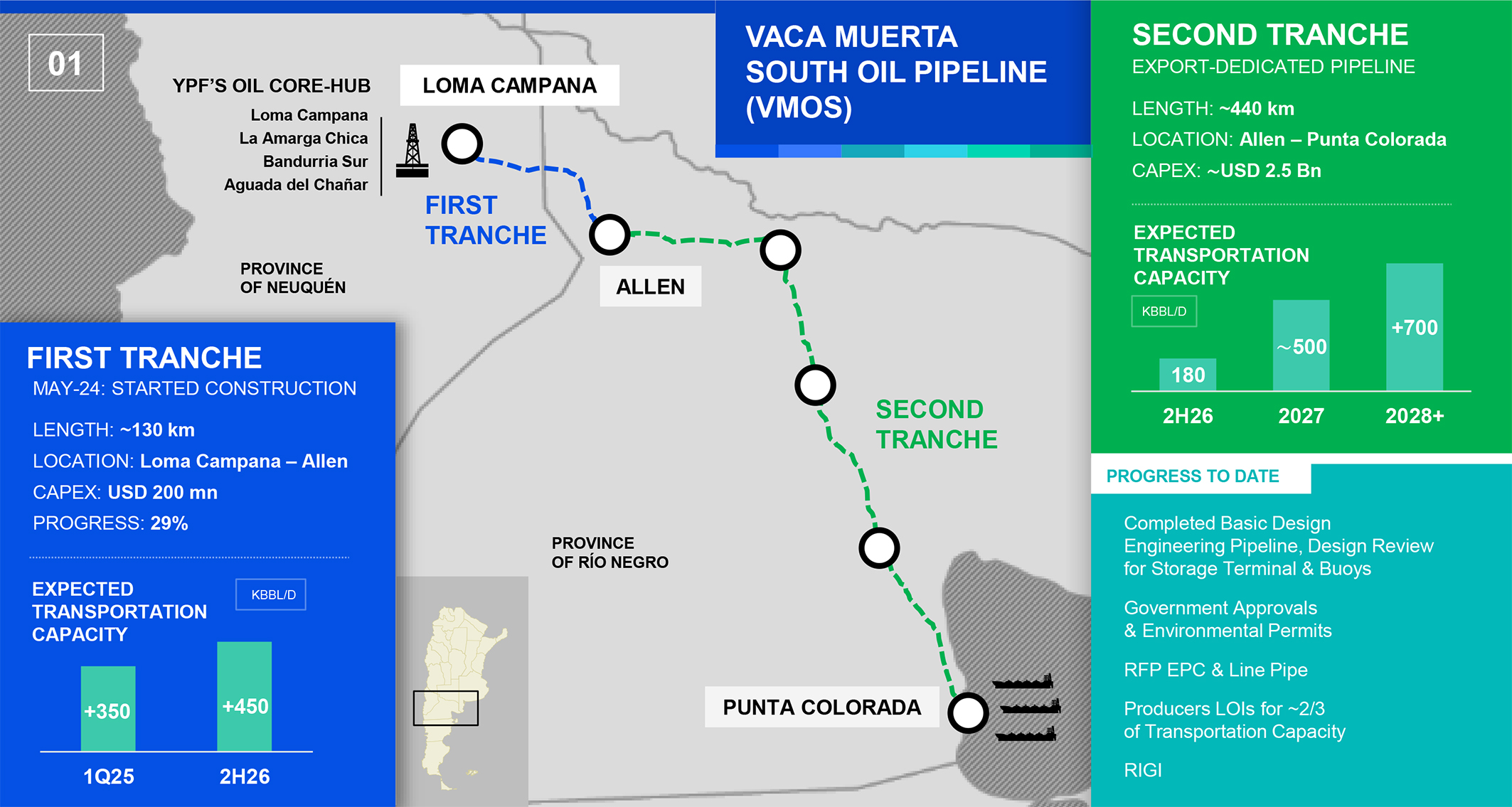March 2025, Vol. 252, No. 3
Features
Argentina’s Allen-Punta Colorada Pipeline Well Underway
By Mauro Nogarin, Latin America Correspondent
(P&GJ) – The Argentine oil company YPF confirmed the start of construction work on the second section of the Vaca Muerta Sur (VMOS) pipeline — a key project to export crude oil production from Neuquén to the Atlantic Ocean.
The company has already awarded the supply of pipes to Tenaris, a subsidiary of the Techint Group, by signing a contract worth $180 million.
The new infrastructure is divided into two sections, with the first involving construction of an 81-mile (130-km) pipeline that connects Loma Campana to Allen. It should be completed in the first quarter of the year.
The second, a 272-mile (437-km) section, connects the town of Allen in Río Negro to the port of Punta Colorada. According to YPF, this section will be completed by the second half of 2026.
This translates to the VMOS transporting 550,000 bpd, which will be mainly destined for export markets. However, it has been estimated that the capacity could reach up to 700,000 bpd with the second phase.
The Vaca Muerta Oleoducto Sur (VMOS) consortium responsible is a new private company, founded by YPF along with six partners: PAE, Pluspetrol, Vista, Pampa Energía, Shell Argentina and Chevrón, which will be in charge of financing, although the last two companies still have to validate the agreement of their foreign subsidiaries.
The route of Section 2 of the Vaca Muerta Sur Pipeline begins at the pumping station located in Allen, where Section 1 ends. From this point, the pipeline follows a (110-km) route until it deviates south to the town of Chelforó. At that point, the pipeline crosses Rio Negro and Provincial Route No. 7, where directional drilling will become necessary, because the pipeline will cross provincial Highways 4, 5 and 9 and national Highways 23 and 3.

Pipeline Route and Information
For an overview of this project and other related infrastructure developments, visit Global Energy Infrastructure.
From this point, the route deviates again in a south-by-southeast direction for 310 km, with a trajectory that goes toward the port of Punta Colorada.
The project will consist of 30-inch API 5L X70 steel pipes, with wall thicknesses of 11.13 mm and 17.5 mm, which will be used to cross roads or rivers. The operating pressure is 194 lb/cm (88 kg/cm2), and it has 30 blocking valves, along with scraper launchers and receivers.
Cathodic protection systems against corrosion will be installed along the route, as well as a fiberoptic SCADA system, to monitor the flow and pressure of the required flows from a control room.
From a geological point of view, the North Patagonian massif, which the the first 93 mi (150 km) of the project traverses, consists of a plateau surrounded by sedimentary basins. This consists of sedimentary rocks almost entirely covered by alluvial (clay, silt and sand) deposits.
From that point, it descends south for about 186 miles (300 km) on a plateau until it reaches the coast.
The topographic relief of the area ranges between 60 and 380 meters above sea level, with an average slope of 0.4 percent from the beginning to the end of Section 2. The slope development is relatively gentle except near the crossing of the Rio Negro.
The first stage of the project, at the head station in the town of Allen, will be built with two tanks, each with a capacity of 55,000 m3. In Chelforó, where the first part of the pipeline ends, the pumping station (EB1) will be installed, enabling a capacity of up to 390,000 bpd, which will be increased with a second pumping station (EB2) located 75 miles (120 km) from Chelforó to allow transporting up to 550,000 bpd.
If necessary in the future, the pipeline will reach the total capacity of 700,000 bpd through the installation of another pumping station (EB3).

The terminal located in the Port of Punta Colorada will be equipped with onshore and offshore facilities, where the first will have several storage tanks of 120,000 m3.
In the first phase, the VMOS will have three tanks that can increase up to a maximum of six in the medium term. The storage terminal in Punta Colorada will also have auxiliary services to guarantee its operation in accordance with international safety standards.
The offshore facility will have two dispatch buoys, located 2 and 3.7 nautical miles from the coast. The pair of single buoys will allow oil to be loaded by VLCC vessels, considering that the depth of the Punta Colorada port reaches 131 feet (40 meters). Finally, the Port of Punta Colorada will have an underwater pipelines to connect the land terminal to the two buoys.
The Allen head station receives the crude oil from the Loma Campana treatment plant, stores it in tanks and then sends it to the measurement unit by means of pumps (booster), with a capacity of 1,298 m3/h. From there, it is dispatched by means of three pumps to the stations until reaching the Punta Colorada terminal.
Breakout:
Length: 272 miles (437 km)
Diameter: 30 inches
Pipe: API 5L X70 steel
Operating pressure: 88 kg/cm2
SCADA system with optical fiber
Useful life: 50 years






Comments